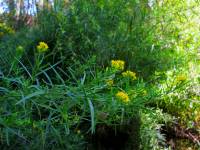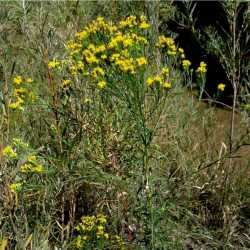|
|
 Leaves Frankie Coburn @http://swbiodiversity.org, Usage Rights: Creative Commons Attribution-ShareAlike (CC BY-SA) |  Plant Max Licher @http://swbiodiversity.org, Usage Rights: Creative Commons Attribution-ShareAlike (CC BY-SA) | | | | |
|
Origin:
Native
Life Cycle:
Perennial
General Desc:
Much-branched spreading to upright plant with thick grayish-green stems growing from horizontal underground stems (rhizomes). Narrow leaves are 3 to 5 veined with many glands. Flowering stalk is a dense, flat-topped cluster of numerous yellow flowerheads.
Identification notes: Stems stout, spreading, ascending to erect, much branched; leaves gland-dotted, 3 to 5 veined, 10 to 27 times longer than wide; ray flowers outnumber disc flowers; flowers in narrow, elongated clusters, bracts light yellowish-brown, often green-tipped.
Height:
To about 6-1/2 feet
Habitat Description: Moist to wet soils of lake shores, ponds, along rivers, streambeds, meadows, freshwater to saline marshes and irrigation ditches. Often grows in association with cattails, rushes and sedges.
Plant Communities:
Riparian, Disturbed Areas
Elevation: 4500 - 7000 feet
Color:
Yellow
Shape:
Daisy or dandelion-like in elongated clusters
Tubular:
N
Flowering Period:
Aug - Sep
Description:
Flowerheads are united into loose clusters at the ends of slim branches. Each flowerhead in the cluster consists of 15 to 25 strap-shaped flowers (ray florets) about 1/16 inch long which surround the 7 to 18 tube-like flowers (disc florets) in the center.
Leaf Color:
Grayish-green
Leaf Type:
Simple
Leaf Shape:
Narrow
Leaf Margin:
Smooth
Leaf Attachment:
Alternate
Leaves Clasp:
N
Hairs:
Leaves
Spines:
N
Leaf Description:
Leaves are stalkless and much longer than wide growing to 4 inches long and from 1/8 to 1/2 inch wide. The leaf margins are rough to the touch (scabrous) due to the presence of short stiff hairs. The upper leaf surface and veins are often sparsely hairy.
Fruit Color: Brown
Fruit Type: Achene
Fruit Notes: The fruit is brown, dry, 1-seeded, narrowly cone-shaped and less than 1/16 inch. It has a light brown to white, bristly parachute-like tuft of hairs (pappus) that is about the length of the fruit and is attached at the wider end aiding in wind dispersal.
Seed Notes: 1 seed is produced by the fruit. The fruit does not open at maturity to release the seed.
|
|